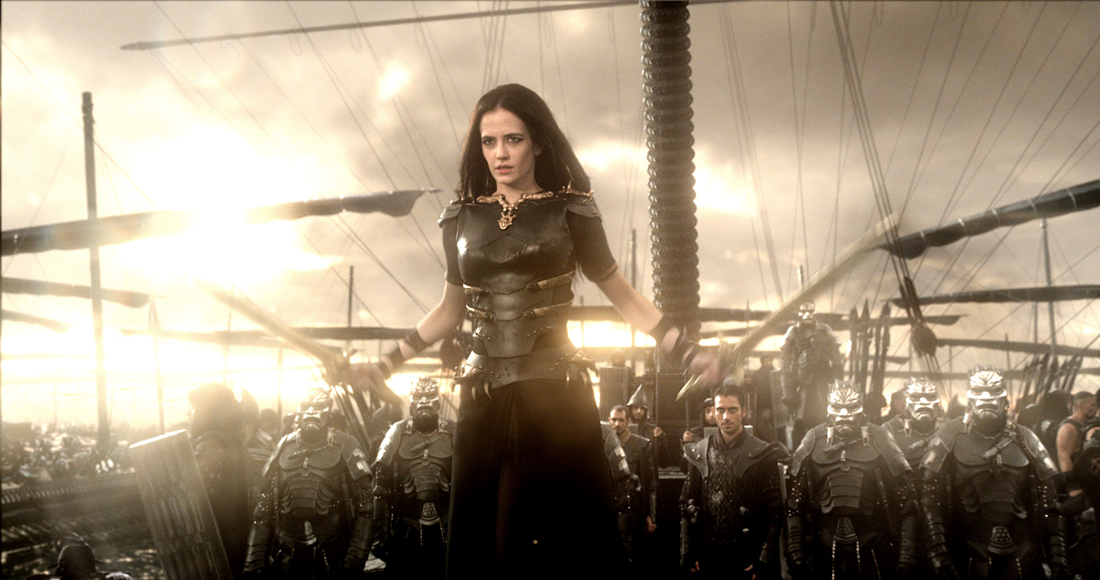Hollywood loves to throw up sequels to successful movies, and some of them do better than others when it comes to standing on their own. Right now, I’m struggling to recall a sequel that’s more heavily haunted by its predecessor’s ghost than 300: Rise of an Empire. Arriving in theaters seven years to the week after Zack Snyder’s hugely influential 300 did, this sequel continues the original’s story and retains its signature look while keeping almost nothing else that made Snyder’s flawed film so popular.
The plot takes up events both before and after the battle of Thermopylae, which was the chief subject of 300. The general and politician Themistocles (Sullivan Stapleton) warns his fellow Athenians that the Persians under Xerxes (Rodrigo Santoro) are coming to conquer them all unless the fractious Greek city-states can stand united against the invaders. Even after the 300 Spartans are martyred, Themistocles has to work to pull the Greeks together and command a navy to withstand the Persian forces at the battle of Salamis.
The main thing that distinguished 300 was its visual style. In contrast to the sun-baked, colorful approach that other toga-and-sandals epics tended to favor, Zack Snyder gave his film a dark, menacing look clouded by the fog of battle. The sequel’s director is Noam Murro, an Israeli filmmaker whose only other movie credit is Smart People, a 2008 literary comedy that could scarcely be more different from this film. Murro follows too closely in Snyder’s footsteps, carefully imitating the original film’s restricted color palette and compositions with the action in the foreground.
The trouble is that Murro doesn’t have Snyder’s flair for action (which, granted, not many filmmakers possess). He manages one nice shot at the climactic Battle of Salamis, when we see the Greek ships turning so that they can ram the Persian ships broadside, where they’re structurally weak. Still, the combat sequences are routine for the most part, and even though Themistocles pulls a number of tricks to repel a superior force, we get little sense of the different tactics involved in the various encounters, as we did in the original. Without Snyder’s flamboyance, the visual style just looks old hat.
The original movie’s banging on about the warrior aesthetic makes an unwelcome return here, too. We do get a note of dissent when Themistocles visits Sparta before Thermopylae to ask for their help. Queen Gorgo (Lena Headey) boasts of how the state teaches children to die gloriously in battle, and the Athenian can’t help muttering, “Shouldn’t you be teaching them to live beside their king?” It’s a welcome rejoinder to the Spartan ideal, but elsewhere this script (by Snyder and Kurt Johnstad) just trafficks in the same pap we’ve heard about the brotherhood of soldiers from a million other movies about war.
There is one saving grace in this movie, and it is Eva Green as Artemisia, the Persian commander who leads the navy against the Greeks and proves the equal of any man in battle. This movie (and the yet-unpublished Frank Miller graphic novel Xerxes, which it’s based on) contrives a back story for Artemisia: that she’s driven by revenge after Greek hoplites killed her family and used her as a sex slave. Truth is, the character hardly needs this, given the badassery brought by the tall, kohl-eyed, deep-voiced Green.
Filmmakers here and in her adopted homeland of Great Britain have struggled to figure out what to do with this unsettling and fiercely sexual presence ever since she burst onto the scene with The Dreamers in 2003. Here she’s wholly in her element as a warrior who’s purposeful enough to decapitate a defiant Greek captive and playful enough to then kiss the man’s severed head, Salome-style. When Artemisia tries to seduce Themistocles to bring him over to the Persians’ side, it results in a sex scene that’s as violent as any of the film’s numerous combat deaths. I’m troubled by the gender implications of this, but that doesn’t obscure Green’s wholehearted commitment to the scene. In a movie cast largely with anonymous Australian dudes, the 33-year-old Brit obliterates everyone else and provides a refreshing tonic to the overbearing maleness of the 300 movies. If the filmmakers had any sense, they’d keep Artemisia around for a sequel about the battle of Mycale, especially since the historical Artemisia seems even more fascinating than the character we see here. Of course, they won’t be keeping her on. That’s part of the problem.
[box_info]
300: Rise of an Empire
Starring Sullivan Stapleton and Eva Green. Directed by Noam Murro. Written by Zack Snyder and Kurt Johnstad, based on Frank Miller’s graphic novel. Rated R.
[/box_info]












